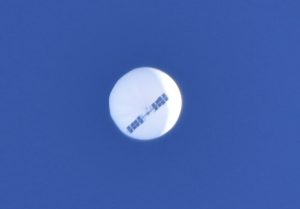Japan has revealed that three unidentified balloon-shaped objects detected over Japan between 2019 and 2021 are now presumed to be Chinese “spy balloons.” It’s the first time Japan has announced the sightings. The Ministry of Defense says it undertook “fresh analysis” on the objects after the United States used F-22 fighter jets to shoot down four aerial objects – one of them confirmed to be a balloon from China – in recent weeks.
Japan and South Korea, both U.S. allies, say they support the United State’s decision to shoot down the aerial objects.
The Japanese government condemned the invasion of its airspace as “unacceptable” and demanded China confirm the facts and prevent a repeat incident. China’s Ministry of Foreign Affairs objected to Japan’s statement that the spy balloon was “presumed to be from China.”
China also repeatedly urged Japan not to follow the U.S. assertion that China is sending surveillance balloons around the world. Foreign Ministry spokesperson Wang Wenbin said China hopes Japan will take an “objective and fair position” and not make a “commotion like the United States.”
This week, there was fierce debate in the lower house of Japan’s Diet over countermeasures in the event a foreign balloon-like object violates Japanese airspace again. The Ministry of Defense explained that currently Japan’s Self-Defense Forces (SDF) can only legally use weapons to bring down aircraft violating Japanese airspace in cases of self-defense or emergency evacuation. The law does not apply to surveillance balloons.
Japan is now considering changing the law to allow the nation’s defense forces to use weapons to shoot down unmanned balloons if doing so is deemed to protect the lives or property of citizens, or if there is a risk the object may interfere in the safe flight of another aircraft.
Japanese Chief Cabinet Secretary Matsuno Hirokazu said Japan would rely on its national armed forces to respond to invading airborne objects in accordance with domestic laws. He rejected the idea of calling on the U.S. military in Japan to shoot down a surveillance balloon.
Surveillance balloons are considered low technology. Yet, their high altitude and slow movement makes them difficult to detect and shoot down, in contrast to ballistic missiles. A Ministry of Defense official told local Japanese media that only a few types of fighter jets, namely F-22s, are able to reach an altitude of 18,000 meters on short notice. The SDF fighter jets such as F-15s can only reach a maximum altitude of 15,000 meters and are not designed to shoot down soft targets. There are also limits to the height of an attack, particularly when the position is higher than the aircraft’s own.
What’s more, Japanese protocol for invading aircraft currently requires the SDF to warn the violating aircraft to either leave or force a landing. Since spy balloons are typically unmanned, those processes will need to be revised.
Some defense experts are calling for prevention as the most cost-effective solution, rather than considering ways to shoot such balloons down with the SDF’s current defense arsenal.
There are also concerns as to whether Japan’s defense system has the ability to identify the risks associated with surveillance balloon-like objects. Aerial objects were sighted over Kagoshima in southern Japan in 2019, Sendai in eastern Japan in June 2020, and Okinawa in 2022. But these incidents failed to make national headlines, and the local authorities say no further investigations were conducted to determine the respective balloons’ origins. Then-Defense Minister Kono Taro dismissed the sightings as unrelated to national security.
Matsuno, the chief cabinet secretary, told reporters on Wednesday that the government “will make efforts to collect more information and conduct more vigilant monitoring in close cooperation with allies and comrades.”
U.S. Deputy Secretary of State Wendy Sherman and Japanese Vice Minister for Foreign Affairs Mori Takeo held talks in Washington, D.C. on Tuesday, where they both agreed the presence of Chinese surveillance balloons over Japan and the United States are a source of provocation and violation of sovereignty and international law.

































